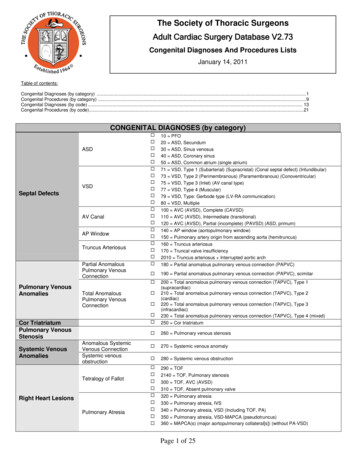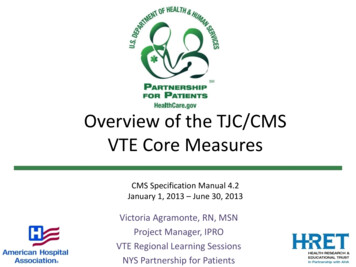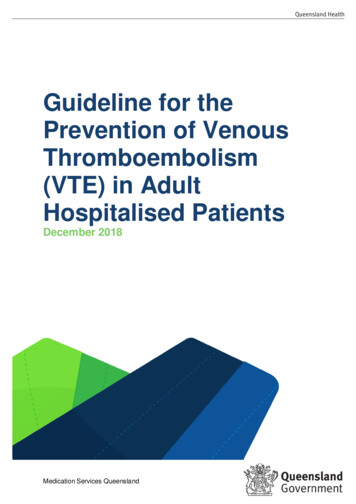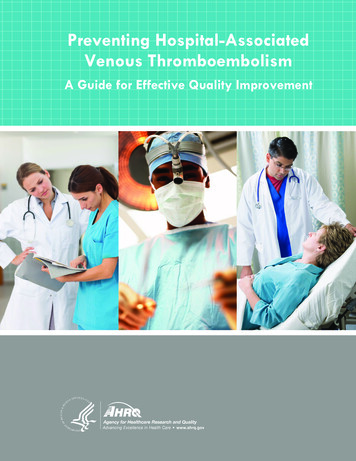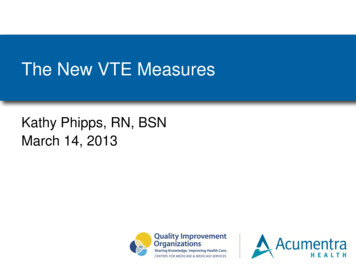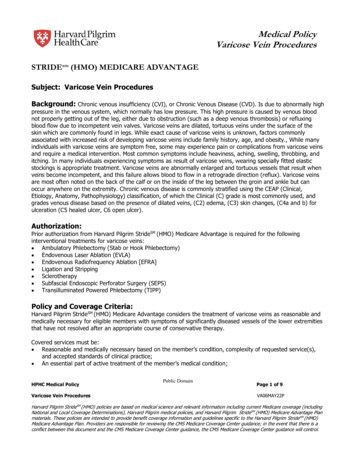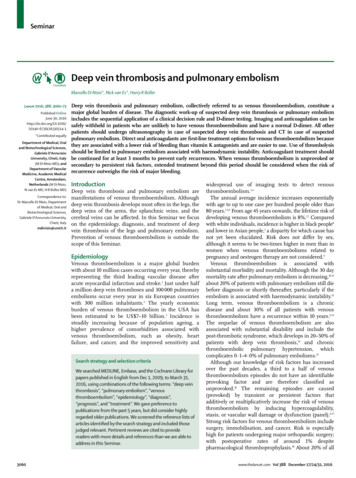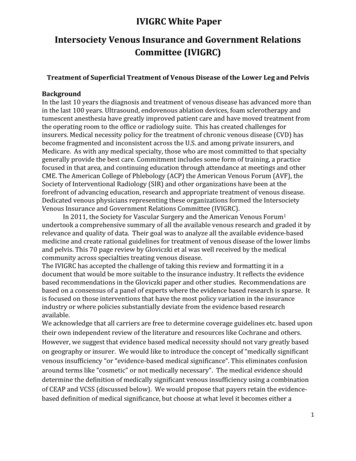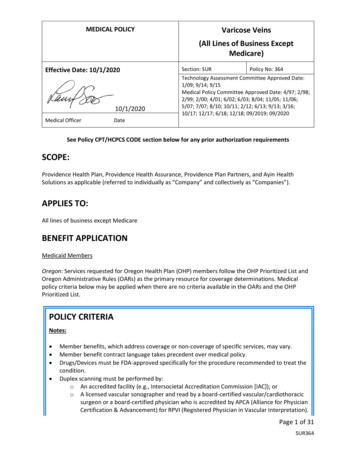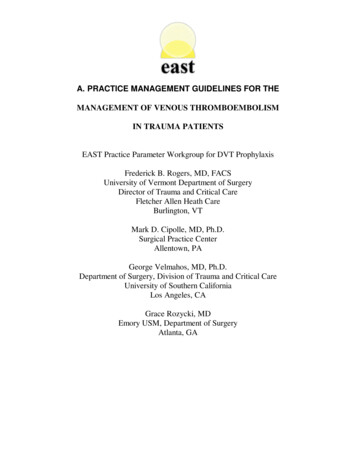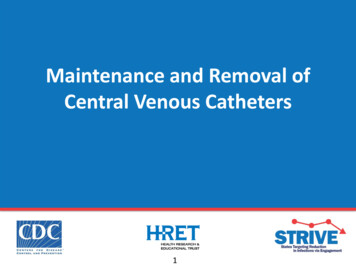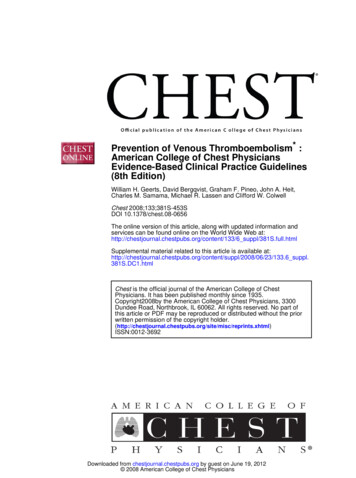
Transcription
Prevention of Venous Thromboembolism* :American College of Chest PhysiciansEvidence-Based Clinical Practice Guidelines(8th Edition)William H. Geerts, David Bergqvist, Graham F. Pineo, John A. Heit,Charles M. Samama, Michael R. Lassen and Clifford W. ColwellChest 2008;133;381S-453SDOI 10.1378/chest.08-0656The online version of this article, along with updated information andservices can be found online on the World Wide Web at:http://chestjournal.chestpubs.org/content/133/6 suppl/381S.full.htmlSupplemental material related to this article is available /2008/06/23/133.6 suppl.381S.DC1.htmlChest is the official journal of the American College of ChestPhysicians. It has been published monthly since 1935.Copyright2008by the American College of Chest Physicians, 3300Dundee Road, Northbrook, IL 60062. All rights reserved. No part ofthis article or PDF may be reproduced or distributed without the priorwritten permission of the copyright c/reprints.xhtml)ISSN:0012-3692Downloaded from chestjournal.chestpubs.org by guest on June 19, 2012 2008 American College of Chest Physicians
SupplementANTITHROMBOTIC AND THROMBOLYTIC THERAPY 8TH ED: ACCP GUIDELINESPrevention of Venous Thromboembolism*American College of Chest Physicians EvidenceBased Clinical Practice Guidelines (8th Edition)William H. Geerts, MD, FCCP; David Bergqvist, MD, PhD;Graham F. Pineo, MD; John A. Heit, MD; Charles M. Samama, MD, PhD, FCCP;Michael R. Lassen, MD; and Clifford W. Colwell, MDThis article discusses the prevention of venous thromboembolism (VTE) and is part of theAntithrombotic and Thrombolytic Therapy: American College of Chest Physicians EvidenceBased Clinical Practice Guidelines (8th Edition). Grade 1 recommendations are strong andindicate that the benefits do or do not outweigh risks, burden, and costs. Grade 2 suggestionsimply that individual patient values may lead to different choices (for a full discussion of the grading,see the “Grades of Recommendation” chapter by Guyatt et al). Among the key recommendationsin this chapter are the following: we recommend that every hospital develop a formal strategythat addresses the prevention of VTE (Grade 1A). We recommend against the use of aspirin aloneas thromboprophylaxis for any patient group (Grade 1A), and we recommend that mechanicalmethods of thromboprophylaxis be used primarily for patients at high bleeding risk (Grade 1A)or possibly as an adjunct to anticoagulant thromboprophylaxis (Grade 2A).For patients undergoing major general surgery, we recommend thromboprophylaxis with alow-molecular-weight heparin (LMWH), low-dose unfractionated heparin (LDUH), or fondaparinux (each Grade 1A). We recommend routine thromboprophylaxis for all patients undergoingmajor gynecologic surgery or major, open urologic procedures (Grade 1A for both groups), withLMWH, LDUH, fondaparinux, or intermittent pneumatic compression (IPC).For patients undergoing elective hip or knee arthroplasty, we recommend one of the followingthree anticoagulant agents: LMWH, fondaparinux, or a vitamin K antagonist (VKA); internationalnormalized ratio (INR) target, 2.5; range, 2.0 to 3.0 (each Grade 1A). For patients undergoing hipfracture surgery (HFS), we recommend the routine use of fondaparinux (Grade 1A), LMWH(Grade 1B), a VKA (target INR, 2.5; range, 2.0 to 3.0) [Grade 1B], or LDUH (Grade 1B). Werecommend that patients undergoing hip or knee arthroplasty or HFS receive thromboprophylaxis for a minimum of 10 days (Grade 1A); for hip arthroplasty and HFS, we recommendcontinuing thromboprophylaxis 10 days and up to 35 days (Grade 1A). We recommend that allmajor trauma and all spinal cord injury (SCI) patients receive thromboprophylaxis (Grade 1A). Inpatients admitted to hospital with an acute medical illness, we recommend thromboprophylaxiswith LMWH, LDUH, or fondaparinux (each Grade 1A). We recommend that, on admission to theICU, all patients be assessed for their risk of VTE, and that most receive thromboprophylaxis(Grade 1A).(CHEST 2008; 133:381S– 453S)Key words: aspirin; deep vein thrombosis; fondaparinux; graduated compression stockings; heparin; intermittentpneumatic compression; low-molecular-weight heparin; pulmonary embolism; thromboprophylaxis; venous foot pump;venous thromboembolism; warfarinAbbreviations: CABG coronary artery bypass graft; CI confidence interval; CVC central venous catheter;DUS Doppler ultrasonography; DVT deep vein thrombosis; FUT fibrinogen uptake test; GCS graduatedcompression stockings; HFS hip fracture surgery; HIT heparin-induced thrombocytopenia; INR internationalnormalized ratio; IPC intermittent pneumatic compression; IVC inferior vena cava; LDUH low-dose unfractionated heparin; LMWH low-molecular-weight heparin; NNH number needed to harm; NNT number neededto treat; NS not significant; OR odds ratio; PE pulmonary embolism; RAM risk assessment model;RRR relative risk reduction; SC subcutaneous; SCI spinal cord injury; THR total hip replacement; TKR totalknee replacement; VFP venous foot pump; VKA vitamin K antagonist; VTE venous thromboembolismwww.chestjournal.orgCHEST / 133 / 6 / JUNE, 2008 SUPPLEMENTDownloaded from chestjournal.chestpubs.org by guest on June 19, 2012 2008 American College of Chest Physicians381S
Summary of Recommendations1.0 General RecommendationsHospital Thromboprophylaxis Policy1.2.1. For every general hospital, we recommend that a formal, active strategy that addresses the prevention of VTE be developed(Grade 1A).1.2.2. We recommend that the local thromboprophylaxis strategy be in the form of a written,institution-wide thromboprophylaxis policy(Grade 1C).1.2.3. We recommend the use of strategiesshown to increase thromboprophylaxis adherence, including the use of computer decisionsupport systems (Grade 1A), preprinted orders(Grade 1B), and periodic audit and feedback(Grade 1C). Passive methods such as distributionof educational materials or educational meetings are not recommended as sole strategies toincrease adherence to thromboprophylaxis(Grade 1B).Anticoagulant Dosing1.4.5. For each of the antithrombotic agents, werecommend that clinicians follow the manufacturer-suggested dosing guidelines (Grade 1C).Renal Impairment and Anticoagulant Dosing1.4.6. We recommend that renal function beconsidered when making decisions about theuse and/or the dose of LMWH, fondaparinux,and other antithrombotic drugs that are clearedby the kidneys, particularly in elderly patients,patients with diabetes mellitus, and those athigh risk for bleeding (Grade 1A). Depending onthe circumstances, we recommend one of thefollowing options in this situation: avoiding theuse of an anticoagulant that bioaccumulates inthe presence of renal impairment, using a lowerdose of the agent, or monitoring the drug levelor its anticoagulant effect (Grade 1B).Mechanical Methods of ThromboprophylaxisAntithrombotic Drugs and Neuraxial Anesthesia/Analgesia or Peripheral Nerve Blocks1.4.3.1. We recommend that mechanical methods of thromboprophylaxis be used primarily inpatients at high risk for bleeding (Grade 1A), orpossibly as an adjunct to anticoagulant-basedthromboprophylaxis (Grade 2A).1.4.3.2. For patients receiving mechanicalmethods of thromboprophylaxis, we recommend that careful attention be directed towardensuring the proper use of, and optimal adherence with, these methods (Grade 1A).1.5.1. For all patients undergoing neuraxialanesthesia or analgesia, we recommend appropriate patient selection and caution when usinganticoagulant thromboprophylaxis (Grade 1A).1.5.2. For patients receiving deep peripheralnerve blocks, we recommend that the samecautions considered for neuraxial techniques beapplied when using anticoagulant thromboprophylaxis (Grade 1C).Aspirin as Thromboprophylaxis1.4.4. We recommend against the use of aspirinalone as thromboprophylaxis against VTE forany patient group (Grade 1A).*From Sunnybrook Health Sciences Centre (Dr. Geerts), University of Toronto, Toronto, ON, Canada; University Hospital(Dr. Bergqvist), Uppsala, Sweden; Foothills Hospital (Dr. Pineo),University of Calgary, Calgary, AB, Canada; Mayo Clinic (Dr.Heit), Rochester, MN; Hôtel-Dieu University Hospital (Dr.Samama), Paris, France; Hoersholm Hospital (Dr. Lassen),Hoersholm, Denmark; and Scripps Clinic (Dr. Colwell), La Jolla,CA.Manuscript accepted December 20, 2007.Reproduction of this article is prohibited without written permissionfrom the American College of Chest Physicians ondence to: William H. Geerts, MD, FCCP, Thromboembolism Program, Sunnybrook Health Sciences Centre, RoomD674, 2075 Bayview Ave, Toronto, ON, Canada M4N 3M5DOI: 10.1378/chest.08-0656382S2.0 General, Vascular, Gynecologic, Urologic,Laparoscopic, Bariatric, Thoracic, and CoronaryArtery Bypass Surgery2.1 General Surgery2.1.1. For low-risk general surgery patients whoare undergoing minor procedures and have noadditional thromboembolic risk factors, we recommend against the use of specific thromboprophylaxis other than early and frequent ambulation (Grade 1A).2.1.2. For moderate-risk general surgery patients who are undergoing a major procedurefor benign disease, we recommend thromboprophylaxis with LMWH, LDUH, or fondaparinux (each Grade 1A).2.1.3. For higher-risk general surgery patientsAntithrombotic and Thrombolytic Therapy 8th Ed: ACCP GuidelinesDownloaded from chestjournal.chestpubs.org by guest on June 19, 2012 2008 American College of Chest Physicians
who are undergoing a major procedure forcancer, we recommend thromboprophylaxiswith LMWH, LDUH three times daily, orfondaparinux (each Grade 1A).2.1.4. For general surgery patients with multiple risk factors for VTE who are thought to beat particularly high risk, we recommend that apharmacologic method (ie, LMWH, LDUHthree times daily, or fondaparinux) be combined with the optimal use of a mechanicalmethod (ie, graduated compression stockings[GCS] and/or IPC) [Grade 1C].2.1.5. For general surgery patients with a highrisk of bleeding, we recommend the optimal useof mechanical thromboprophylaxis with properly fitted GCS or IPC (Grade 1A). When thehigh bleeding risk decreases, we recommendthat pharmacologic thromboprophylaxis besubstituted for or added to the mechanicalthromboprophylaxis (Grade 1C).2.1.6. For patients undergoing major generalsurgical procedures, we recommend thatthromboprophylaxis continue until dischargefrom hospital (Grade 1A). For selected high-riskgeneral surgery patients, including some ofthose who have undergone major cancer surgery or have previously had VTE, we suggestthat continuing thromboprophylaxis after hospital discharge with LMWH for up to 28 days beconsidered (Grade 2A).2.2 Vascular Surgery2.2.1. For patients undergoing vascular surgerywho do not have additional thromboembolicrisk factors, we suggest that clinicians not routinely use specific thromboprophylaxis otherthan early and frequent ambulation (Grade 2B).2.2.2. For patients undergoing major vascularsurgery procedures who have additional thromboembolic risk factors, we recommend thromboprophylaxis with LMWH, LDUH, or fondaparinux (Grade 1C).2.3 Gynecologic Surgery2.3.1. For low-risk gynecologic surgery patientswho are undergoing minor procedures andhave no additional risk factors, we recommendagainst the use of specific thromboprophylaxisother than early and frequent ambulation(Grade 1A).2.3.2. For gynecology patients undergoing entirely laparoscopic procedures, we recommendagainst routine thromboprophylaxis, other thanearly and frequent ambulation (Grade 1B).www.chestjournal.org2.3.3. For gynecology patients undergoing entirely laparoscopic procedures in whom additional VTE risk factors are present, we recommend the use of thromboprophylaxis withone or more of LMWH, LDUH, IPC, or GCS(Grade 1C).2.3.4. For all patients undergoing major gynecologic surgery, we recommend thatthromboprophylaxis be used routinely (Grade1A).2.3.5. For patients undergoing major gynecologic surgery for benign disease without additional risk factors, we recommend LMWH(Grade 1A), LDUH (Grade 1A), or IPC startedjust before surgery and used continuouslywhile the patient is not ambulating (Grade 1B).2.3.6. For patients undergoing extensive surgery for malignancy and for patients withadditional VTE risk factors, we recommendroutine thromboprophylaxis with LMWH(Grade 1A), or LDUH three times daily (Grade1A), or IPC, started just before surgery andused continuously while the patient is not ambulating (Grade 1A). Alternative considerationsinclude a combination of LMWH or LDUH plusmechanical thromboprophylaxis with GCS orIPC, or fondaparinux (all Grade 1C).2.3.7. For patients undergoing major gynecologicprocedures, we recommend that thromboprophylaxis continue until discharge from hospital (Grade1A). For selected high-risk gynecology patients,including some of those who have undergonemajor cancer surgery or have previously hadVTE, we suggest that continuing thromboprophylaxis after hospital discharge with LMWH for upto 28 days be considered (Grade 2C).2.4 Urologic Surgery2.4.1. For patients undergoing transurethral orother low-risk urologic procedures, we recommend against the use of specific thromboprophylaxis other than early and frequent ambulation (Grade 1A).2.4.2. For all patients undergoing major, openurologic procedures, we recommend that thromboprophylaxis be used routinely (Grade 1A).2.4.3. For patients undergoing major, open urologic procedures, we recommend routine thromboprophylaxis with LDUH twice daily or threetimes daily (Grade 1B), GCS and/or IPC startedjust before surgery and used continuously whilethe patient is not ambulating (Grade 1B), LMWH(Grade 1C), fondaparinux (Grade 1C), or the combination of a pharmacologic method (ie, LMWH,LDUH, or fondaparinux) with the optimal use of aCHEST / 133 / 6 / JUNE, 2008 SUPPLEMENTDownloaded from chestjournal.chestpubs.org by guest on June 19, 2012 2008 American College of Chest Physicians383S
mechanical method (ie, GCS and/or IPC) [Grade1C].2.4.4. For urologic surgery patients who are actively bleeding, or who are at very high risk forbleeding, we recommend the optimal use of mechanical thromboprophylaxis with GCS and/orIPC at least until the bleeding risk decreases(Grade 1A). When the high bleeding risk decreases, we recommend that pharmacologicthromboprophylaxis be substituted for or addedto the mechanical thromboprophylaxis (Grade1C).2.5 Laparoscopic Surgery2.5.1. For patients undergoing entirely laparoscopic procedures who do not have additionalthromboembolic risk factors, we recommendagainst the routine use of thromboprophylaxis,other than early and frequent ambulation(Grade 1B).2.5.2. For patients undergoing laparoscopic procedures in whom additional VTE risk factors arepresent, we recommend the use of thromboprophylaxis with one or more of LMWH, LDUH,fondaparinux, IPC, or GCS (all Grade 1C).2.6 Bariatric Surgery2.6.1. For patients undergoing inpatient bariatric surgery, we recommend routine thromboprophylaxis with LMWH, LDUH three timesdaily, fondaparinux, or the combination of one ofthese pharmacologic methods with optimally usedIPC (each Grade 1C).2.6.2. For patients undergoing inpatient bariatricsurgery, we suggest that higher doses of LMWHor LDUH than usual for nonobese patients beused (Grade 2C).optimally used bilateral GCS or IPC (Grade 1C).2.8.2. For patients undergoing CABG, we suggestthe use of LMWH over LDUH (Grade 2B).2.8.3. For patients undergoing CABG with a highrisk of bleeding, we recommend the optimal use ofmechanical thromboprophylaxis with properly fitted bilateral GCS or IPC (Grade 1C).3.0 Orthopedic Surgery3.1 Elective Hip Replacement3.1.1. For patients undergoing elective total hipreplacement (THR), we recommend the routineuse of one of the following anticoagulant options: (1) LMWH (at a usual high-risk dose,started 12 h before surgery or 12 to 24 h aftersurgery, or 4 to 6 h after surgery at half theusual high-risk dose and then increasing to theusual high-risk dose the following day); (2)fondaparinux (2.5 mg started 6 to 24 h aftersurgery); or (3) adjusted-dose VKA started preoperatively or the evening of the surgical day(international normalized ratio [INR] target,2.5; INR range, 2.0 to 3.0) (all Grade 1A).3.1.2. For patients undergoing THR, we recommend against the use of any of the following:aspirin, dextran, LDUH, GCS, or venous footpump (VFP) as the sole method of thromboprophylaxis (all Grade 1A).3.1.3. For patients undergoing THR who have ahigh risk of bleeding, we recommend the optimal use of mechanical thromboprophylaxis withthe VFP or IPC (Grade 1A). When the highbleeding risk decreases, we recommend thatpharmacologic thromboprophylaxis be substituted for or added to the mechanical thromboprophylaxis (Grade 1C).3.2 Elective Knee Replacement2.7 Thoracic Surgery2.7.1. For patients undergoing major thoracicsurgery, we recommend routine thromboprophylaxis with LMWH, LDUH, or fondaparinux(each Grade 1C).2.7.2. For thoracic surgery patients with a highrisk of bleeding, we recommend the optimal useof mechanical thromboprophylaxis with properly fitted GCS and/or IPC (Grade 1C).2.8 Coronary Artery Bypass Surgery2.8.1. For patients undergoing coronary artery bypass graft (CABG) surgery, we recommend the useof thromboprophylaxis with LMWH, LDUH, or384S3.2.1. For patients undergoing TKR, we recommend routine thromboprophylaxis using LMWH(at the usual high-risk dose), fondaparinux, oradjusted-dose VKA (INR target, 2.5; INR range,2.0 to 3.0) (all Grade 1A).3.2.2. For patients undergoing TKR, the optimaluse of IPC is an alternative option to anticoagulant thromboprophylaxis (Grade 1B).3.2.3. For patients undergoing TKR, we recommend against the use of any of the following as theonly method of thromboprophylaxis: aspirin(Grade 1A), LDUH (Grade 1A), or VFP (Grade 1B).3.2.4. For patients undergoing TKR who have ahigh risk of bleeding, we recommend the optimaluse of mechanical thromboprophylaxis with IPCAntithrombotic and Thrombolytic Therapy 8th Ed: ACCP GuidelinesDownloaded from chestjournal.chestpubs.org by guest on June 19, 2012 2008 American College of Chest Physicians
(Grade 1A) or VFP (Grade 1B). When the highbleeding risk decreases, we recommend thatpharmacologic thromboprophylaxis be substituted for or added to the mechanical thromboprophylaxis (Grade 1C).3.3 Knee Arthroscopy3.3.1. For patients undergoing knee arthroscopy who do not have additional thromboembolic risk factors, we suggest that clinicians notroutinely use thromboprophylaxis other thanearly mobilization (Grade 2B).3.3.2. For patients undergoing arthroscopicknee surgery who have additional thromboembolic risk factors or following a complicatedprocedure, we recommend thromboprophylaxiswith LMWH (Grade 1B).3.4 Hip Fracture Surgery3.4.1. For patients undergoing HFS, we recommend routine thromboprophylaxis using fondaparinux (Grade 1A), LMWH (Grade 1B), adjusteddose VKA (INR target, 2.5; INR range, 2.0 to 3.0)[Grade 1B], or LDUH (Grade 1B).3.4.2. For patients undergoing HFS, we recommend against the use of aspirin alone (Grade 1A).3.4.3. For patients undergoing HFS in whomsurgery is likely to be delayed, we recommendthat thromboprophylaxis with LMWH or LDUHbe initiated during the time between hospitaladmission and surgery (Grade 1C).3.4.4. For patients undergoing HFS who have ahigh risk of bleeding, we recommend the optimaluse of mechanical thromboprophylaxis (Grade1A). When the high bleeding risk decreases, werecommend that pharmacologic thromboprophylaxis be substituted for or added to the mechanical thromboprophylaxis (Grade 1C).3.5 Other Thromboprophylaxis Issues in MajorOrthopedic Surgery3.5.1 Commencement of Thromboprophylaxis3.5.1.1. For patients receiving LMWH as thromboprophylaxis in major orthopedic surgery, werecommend starting either preoperatively orpostoperatively (Grade 1A).3.5.1.2. For patients receiving fondaparinux asthromboprophylaxis in major orthopedic surgery, we recommend starting either 6 to 8 hafter surgery or the next day (Grade 1A).www.chestjournal.orgScreening for Deep Vein Thrombosis BeforeHospital Discharge3.5.2. For asymptomatic patients following major orthopedic surgery, we recommend againstthe routine use of DUS screening before hospital discharge (Grade 1A).Duration of Thromboprophylaxis3.5.3.1. For patients undergoing THR, TKR, orHFS, we recommend thromboprophylaxis withone of the recommended options for at least 10days (Grade 1A).3.5.3.2. For patients undergoing THR, we recommend that thromboprophylaxis be extendedbeyond 10 days and up to 35 days after surgery(Grade 1A). The recommended options for extended thromboprophylaxis in THR includeLMWH (Grade 1A), a VKA (Grade 1B), orfondaparinux (Grade 1C).3.5.3.3. For patients undergoing TKR, we suggest that thromboprophylaxis be extended beyond 10 days and up to 35 days after surgery(Grade 2B). The recommended options for extended thromboprophylaxis in TKR includeLMWH (Grade 1C), a VKA (Grade 1C), orfondaparinux (Grade 1C).3.5.3.4. For patients undergoing HFS, we recommend that thromboprophylaxis be extendedbeyond 10 days and up to 35 days after surgery(Grade 1A). The recommended options for extended thromboprophylaxis in HFS includefondaparinux (Grade 1A), LMWH (Grade 1C), ora VKA (Grade 1C).3.6 Elective Spine Surgery3.6.1. For patients undergoing spine surgerywho do not have additional thromboembolicrisk factors, we suggest that clinicians not routinely use specific thromboprophylaxis otherthan early and frequent ambulation (Grade 2C).3.6.2. For patients undergoing spine surgerywho have additional thromboembolic risk factors such as advanced age, malignancy, presence of a neurologic deficit, previous VTE, oran anterior surgical approach, we recommendthat one of the following thromboprophylaxisoptions be used: postoperative LDUH (Grade1B), postoperative LMWH (Grade 1B), or optimal use of perioperative IPC (Grade 1B). Analternative consideration is GCS (Grade 2B).3.6.3. For patients undergoing spine surgerywho have multiple risk factors for VTE, wesuggest that a pharmacologic method (ie,CHEST / 133 / 6 / JUNE, 2008 SUPPLEMENTDownloaded from chestjournal.chestpubs.org by guest on June 19, 2012 2008 American College of Chest Physicians385S
LDUH or LMWH) be combined with the optimal use of a mechanical method (ie, GCS and/orIPC) (Grade 2C).3.7 Isolated Lower-Extremity Injuries Distal tothe Knee3.7.1. For patients with isolated lower-extremityinjuries distal to the knee, we suggest thatclinicians not routinely use thromboprophylaxis(Grade 2A).4.0 Neurosurgery4.0.1. For patients undergoing major neurosurgery, we recommend that thromboprophylaxisbe used routinely (Grade 1A), with optimal useof IPC (Grade 1A). Acceptable alternatives toIPC are post operative LMWH (Grade 2A) orLDUH (Grade 2B).4.0.2. For patients undergoing major neurosurgery who have a particularly high thrombosisrisk, we suggest that a mechanical method (ie,GCS and/or IPC) be combined with a pharmacologic method (ie, postoperative LMWH orLDUH) (Grade 2B).5.0 Trauma, Spinal Cord Injury, Burns5.1 Trauma5.1.1. For all major trauma patients, we recommend routine thromboprophylaxis if possible(Grade 1A).5.1.2. For major trauma patients, in the absenceof a major contraindication, we recommendthat clinicians use LMWH thromboprophylaxisstarting as soon as it is considered safe to do so(Grade 1A). An acceptable alternative is thecombination of LMWH and the optimal use of amechanical method of thromboprophylaxis(Grade 1B).5.1.3. For major trauma patients, if LMWHthromboprophylaxis is contraindicated due toactive bleeding or high risk for clinically important bleeding, we recommend that mechanicalthromboprophylaxis with IPC or possibly withGCS alone be used (Grade 1B). When the highbleeding risk decreases, we recommend thatpharmacologic thromboprophylaxis be substituted for or added to the mechanical thromboprophylaxis (Grade 1C).5.1.4. In trauma patients, we recommendagainst routine DUS screening for asymptomatic deep vein thrombosis (DVT) (Grade 1B).We do recommend DUS screening in patients386Swho are at high risk for VTE (eg, in thepresence of a spinal cord injury [SCI], lowerextremity or pelvic fracture, or major headinjury), and who have received suboptimalthromboprophylaxis or no thromboprophylaxis (Grade 1C).5.1.5. For trauma patients, we recommendagainst the use of an inferior vena cava (IVC)filter as thromboprophylaxis (Grade 1C).5.1.6. For major trauma patients, we recommend the continuation of thromboprophylaxisuntil hospital discharge (Grade 1C). Fortrauma patients with impaired mobility whoundergo inpatient rehabilitation, we suggestcontinuing thromboprophylaxis with LMWHor a VKA (target INR, 2.5; range, 2.0 to 3.0)(Grade 2C).5.2 Acute Spinal Cord Injury5.2.1. For all patients with acute SCI, we recommend that routine thromboprophylaxis beprovided (Grade 1A).5.2.2. For patients with acute SCI, we recommend thromboprophylaxis with LMWH, commenced once primary hemostasis is evident(Grade 1B). Alternatives include the combineduse of IPC and either LDUH (Grade 1B) orLWMH (Grade 1C).5.2.3. For patients with acute SCI, we recommend the optimal use of IPC and/or GCS ifanticoagulant thromboprophylaxis is contraindicated because of high bleeding risk earlyafter injury (Grade 1A). When the high bleedingrisk decreases, we recommend that pharmacologic thromboprophylaxis be substituted for oradded to the mechanical thromboprophylaxis(Grade 1C).5.2.4. For patients with an incomplete SCI associated with evidence of a spinal hematoma onCT or MRI, we recommend the use of mechanical thromboprophylaxis instead of anticoagulant thromboprophylaxis at least for the firstfew days after injury (Grade 1C).5.2.5. Following acute SCI, we recommendagainst the use of LDUH alone (Grade 1A).5.2.6. For patients with SCI, we recommendagainst the use of an IVC filter as thromboprophylaxis (Grade 1C).5.2.7. For patients undergoing rehabilitationfollowing acute SCI, we recommend the continuation of LMWH thromboprophylaxis or conversion to an oral VKA (INR target, 2.5; range,2.0 to 3.0) (Grade 1C).Antithrombotic and Thrombolytic Therapy 8th Ed: ACCP GuidelinesDownloaded from chestjournal.chestpubs.org by guest on June 19, 2012 2008 American College of Chest Physicians
5.3 Burns5.3.1. For burn patients who have additionalrisk factors for VTE, including one or more ofthe following: advanced age, morbid obesity,extensive or lower-extremity burns, concomitant lower-extremity trauma, use of a femoralvenous catheter, and/or prolonged immobility, we recommend routine thromboprophylaxis if possible (Grade 1A).5.3.2. For burn patients who have additionalrisk factors for VTE, if there are no contraindications, we recommend the use of eitherLMWH or LDUH starting as soon as it isconsidered safe to do so (Grade 1C).5.3.3. For burn patients who have a highbleeding risk, we recommend mechanicalthromboprophylaxis with GCS and/or IPC until the bleeding risk decreases (Grade 1A).6.0 Medical Conditions6.0.1. For acutely ill medical patients admittedto hospital with congestive heart failure orsevere respiratory disease, or who are confinedto bed and have one or more additional riskfactors, including active cancer, previous VTE,sepsis, acute neurologic disease, or inflammatory bowel disease, we recommend thromboprophylaxis with LMWH (Grade 1A), LDUH(Grade 1A), or fondaparinux (Grade 1A).6.0.2. For medical patients with risk factors forVTE, and for whom there is a contraindicationto anticoagulant thromboprophylaxis, we recommend the optimal use of mechanical thromboprophylaxis with GCS or IPC (Grade 1A).7.0 Cancer Patients7.0.1. For cancer patients undergoing surgicalprocedures, we recommend routine thromboprophylaxis that is appropriate for the type ofsurgery (Grade 1A). Refer to the recommendations in the relevant surgical subsections.7.0.2. For cancer patients who are bedriddenwith an acute medical illness, we recommendroutine thromboprophylaxis as for other highrisk medical patients (Grade 1A).Refer to the recommendations in Section 6.0.7.0.3. For cancer patients with indwelling central venous catheters, we recommend that clinicians not use either prophylactic doses ofLMWH (Grade 1B). or minidose warfarin (Grade1B) to try to prevent catheter-related thrombosis.www.chestjournal.org7.0.4. For cancer patients receiving chemotherapy or hormonal therapy, we recommend againstthe routine use of thromboprophylaxis for theprimary prevention of VTE (Grade 1C).7.0.5. For cancer patients, we recommend againstthe routine use of primary thromboprophylaxis totry to improve survival (Grade 1B).8.0 Critical Care8.1. For patients admitted to a critical careunit, we recommend routine assessment forVTE risk and routine thromboprophylaxis inmost (Grade 1A).8.2. For critical care patients who are at moderate risk for VTE (eg, medically ill or postoperativegeneral surgery patients), we recommend using LMWH or LDUH thromboprophylaxis(Grade 1A).8.3. For critical care patients who are athigher risk (eg, following major trauma ororthopedic surgery), we recommend LMWHthromboprophylaxis (Grade 1A).8.4. For critical care patients who are at highrisk for bleeding, we recommend the optimaluse of mechanical thromboprophylaxis withGCS and/or IPC at least until the bleedingrisk decreases (Grade 1A). When the highbleeding risk decreases, we recommend thatpharmacologic thromboprophylaxis be substituted for or added to the mechanical thromboprophylaxis (Grade 1C).9.0 Long-Distance Travel9.1. For travelers who are taking flights 8 h, werecommend the following general measures:avoidance of constrictive clothing around thelower extremities or waist, maintenance of adequate hydration, and frequent calf muscle contraction (Grade 1C).9.2. For long-distance travelers with additionalrisk factors for VTE, we recommend the gene
prophylaxis strategy be in the form of a written, institution-wide thromboprophylaxis policy (Grade 1C). 1.2.3. We recommend the use of strategies shown to increase thromboprophylaxis adher-ence, including the use of computer decision support systems (Grade 1A), preprinted orders (Grade 1B), and periodic audit and feedback (Grade 1C). Passive .
